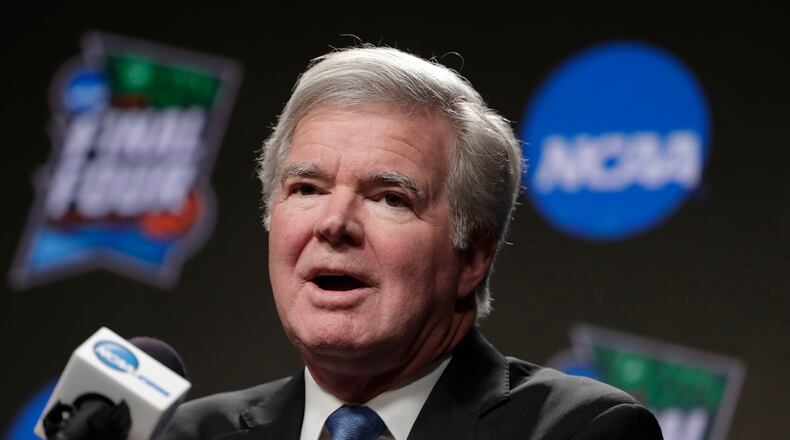The NCAA issues hard-and-fast rules when it seeks to prevent "amateur" athletes from realizing their full market value. Mandates become suggestions when schools want to give the appearance they are looking out for the interests of athletes. No surprise, then, that the NCAA settled on a half-measure while extending eligibility for some athletes whose seasons were cut short because of COVID-19.
Seniors who participated in spring sports and exhausted their eligibility can return for another season. That’s good for them, as far as it goes. It also earns the NCAA a public-relations win. On the surface, the decision is an answer to public calls for those athletes to have a chance to come back.
But schools don’t have to give those athletes the same scholarship they had in 2019-20, or any scholarship at all. The NCAA also didn’t announce a dedicated funding mechanism for scholarships for returning seniors. The NCAA passed the buck, and the financial burden, to individual schools.
It's a suggestion with no cash to carry it out, which disadvantages affected athletes. A mandate with no money would burden schools. Both schools and athletes would benefit if the NCAA required scholarships for returning seniors and funded them. But that would leave less money for other items in a pot that includes $44.8 million for administrative expenses at the NCAA national office.
The NCAA’s decision to award extra eligibility without extra money creates some potentially tough choices for spring sports coaches. Do they give scarce scholarship funds to seniors who wish to return for another season? Do they prod those players out the door to create playing time for younger players and incoming freshmen?
The NCAA release announcing the decision to allow an extra season for some athletes doesn't get into those sticky issues. It does include some of the usual slippery language.
Schools are “encouraged” to act in the “best interest” of athletes, but the NCAA isn’t requiring it. Schools have the “opportunity” to allow athletes for an extra season, but they have the “flexibility” not to award them any scholarship money.
The NCAA is allowing schools to use the Student Assistance Fund to pay for the scholarships of seniors who wish to return. The SAF normally is used to pay for athlete expenses that scholarships don’t cover. But the fund represents a little more than 1 percent of the NCAA’s distribution to schools, and it likely be strained by the current crisis.
The fallout from the coronavirus probably means more athletes than usual will be tapping into the SAF. There also figures to be less money available. The NCAA announced last week that it would distribute $225 million to Division I schools this year instead of the budgeted $600 million. It said the shortfall was created by the cancellation of its big money-maker, the men’s basketball tournament.
It's unlikely there will be enough money for every spring sports senior who wants to return. That was among the list of "recommendations" released by members of the athlete advisory committees for the 60 Power 5 schools. (The students know their audience).
No. 1 on the list: immediate financial support for “athletes who are currently struggling to pay for food and housing” because of circumstances related to COVID-19. The athlete reps also recommended an extra season of eligibility for all athletes in spring sports. They suggested the same for athletes in winter sports who qualified for the postseason and didn’t complete it. Finally, the Power 5 athlete group called for scholarship renewals for those seniors who wish to return.
Ultimately, the NCAA didn’t guarantee those athletes anything on their list. The guaranteed scholarship money was the longest shot. That’s just not a priority for NCAA schools with regard to non-revenue sports.
Those sports give them PR cover for their exploitation of revenue-generating football and basketball players. Maybe you’ve seen the commercials about most NCAA athletes going pro in something other than sports. The commercials don’t mention that a fraction of those athletes receive scholarships.
The NCAA says only 59 percent of Division I athletes receive any amount of athletics aid. It’s a much lower percentage for sports other than basketball and football.
For example, Division I baseball teams are limited to 11.7 scholarships for up to 27 recipients, with a total roster limit of 35. Men’s lacrosse teams split 12 scholarships among about 40 athletes. For men’s volleyball, it’s 4.5 scholarships for about 18 players on a team. Softball allows 12 scholarships for teams that average about 20 players.
It’s good that the NCAA is giving seniors in those spring sports and others a chance to return and compete after the coronavirus upended their seasons. It’s possible that many of those athletes will move on from college sports, anyway. They will leave school for the job market or go on to graduate school.
At least the seniors who want to continue playing college sports have a shot to do so. But the impact of the NCAA’s decision is small because it neither mandates that schools give those athletes the same scholarships nor provides the money to do it. As usual, the NCAA did the bare minimum to help athletes it says “are at the heart of” its mission.
About the Author
The Latest
Featured

